Nodding Wild Onion, Nodding Onion, Allegheny Onion - Allium cernuum
|
Allium cernuum - Nodding Wild Onion, Nodding Onion, Allegheny Onion. Allium cernuum is a widely distributed onion, although it is uncommon in parts of its range. It is found from the east coast to the west coast in the United States, missing in 16 states. It is listed as Threatened in Iowa, Minnesota, and New York, but the entire Allium genus is listed as noxious weeds in Arkansas. Allium is a large genus of up to 700 species, nearly 100 in the United States.
The USDA still lists Allium in the Liliaceae family, although some recent classification efforts have moved it into the Amaryllidaceae - Amaryllis - family (and some into Alliaceae). Since ITIS lists the genus in Amaryllidaceae, I have included the Allium species in that family here as well. Some experts consider Allium allegheniense - Allegheny Onion - as a separate species, but ITIS and Flora of North America consider that to be a synonym of Allium cernuum.
All parts of the plant are edible - standard edibility disclaimer applies: DO NOT EAT A PLANT BASED ON INFORMATION ON THIS WEBSITE - I may be incorrect, or you may not have correctly identified the plant.
Found in:
AL, AR, AZ, CO, DC, GA, IA, ID, IL, IN, KY, MD, MI, MN, MO, MS, MT, NC, NE, NM, NY, OH, OR, PA, SC, SD, TN, TX, UT, VA, WA, WI, WV, WY
Note: Normally all photos I publish are taken in the field. On rare occasions they are taken at my home from a harvested plant. In the case of this plant, due to time constraints in the field most of these photos are from a harvested plant. | 
Distribution of Allium cernuum in the United States and Canada:

Blue=Native; Grey=Introduced
Map from USDA Plants Database:
USDA, NRCS. 2017. The PLANTS Database (http://plants.usda.gov, 08 May 2025). National Plant Data Team, Greensboro, NC 27401-4901 USA.
Search Our Database: Enter any portion of the Scientific, Common Name, or both.
Do a general Google search of the entire site:
#ad
 Follow USWildflowers on Twitter
#ad
| | Site: Hamilton County, TN Date: 2013-August-17 | Photographer: Gerald C. Williamson
Nikon D7000
Tamron SP 90MM f/2.8 AF Macro | | Nodding Wild Onion has 8 to 35 white to rose pink flowers in a nodding umbel. Cernuum is Latin for drooping; it is applied to the scientific name for the plant due to the obvious droop or nod of the inflorescence. Allium cernuum is closely related to Allium stellatum, with the most obvious difference being the distinct nod of the umbel in Allium cernuum. Both nod in bud, but Allium stellatum usually becomes erect by the time the blossoms open. | | 
| | Site: Hamilton County, TN Date: 2013-August-17 | Photographer: Gerald C Williamson
Nikon D7000 | | Since Allium cernuum may straighten somewhat as it matures (recurved peduncle but overall inflorescence appears erect), a more reliable characteristic to tell the difference is the shape of the perianth shape - bell shaped with the tepals erect relative to the pedicel in A. cernuum, but spreading star-like in A. stellatum. | | Click on the photo for a larger image
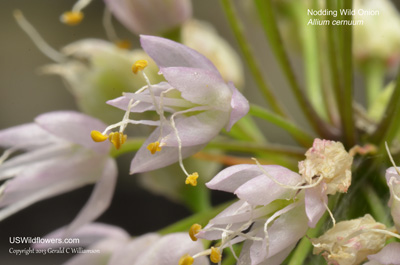
| | Site: Hamilton County, TN Date: 2013-August-17 | Photographer: Gerald C Williamson
Nikon D7000 | | The pedicels are up to about an inch long in Allium cernuum, somewhat shorter in Allium stellatum. In A. cernuum the outer (upper) pedicels curve upward, sometimes masking (from a distance) the nod of the inflorescence. | | Click on the photo for a larger image
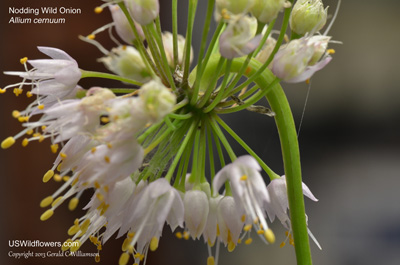
| | Site: Hamilton County, TN Date: 2013-August-22 | Photographer: Gerald C Williamson
Nikon D7000 | | Allium cernuum grows in moist soils, up to about 2 feet tall. It flowers from mid-summer to early-fall. | | Click on the photo for a larger image
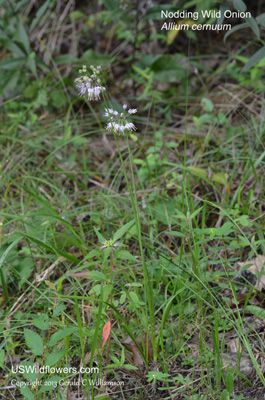
| | Site: Hamilton County, TN Date: 2013-August-17 | Photographer: Gerald C Williamson
Nikon D7000 | | The leaf of Nodding Onion is up to about a foot long and up to about one-third inch wide. It is channeled and flat or v-shaped in cross-section. | | Click on the photo for a larger image
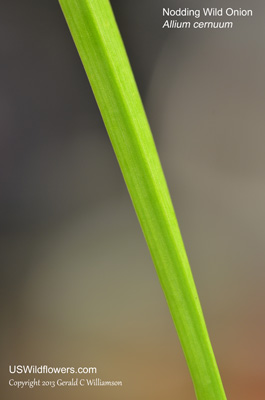
| | Site: Hamilton County, TN Date: 2013-August-17 | Photographer: Gerald C Williamson
Nikon D7000 | | The bulb is somewhat elongate in A. cernuum and ovoid in A. stellatum. | | Click on the photo for a larger image
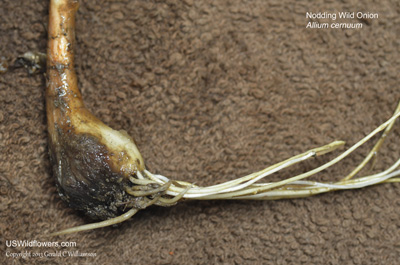
|
References used for identification and information:
|
|
| |
| #ad
|
|








